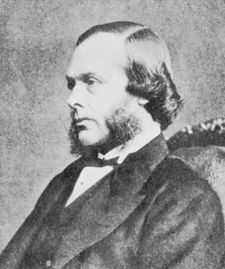Joseph Lister, 1st Baron Lister
| The Lord Lister | |
|---|---|
 |
|
| Born | 5 April 1827 Upton, Essex |
| Died | 10 February 1912 (aged 84) Walmer, Kent |
| Nationality | United Kingdom |
| Fields | Medicine |
| Institutions | University of Glasgow University of Edinburgh University of London |
| Alma mater | University of London |
| Known for | Surgical sterile techniques |
Joseph Lister, 1st Baron Lister OM, FRS , PC (5 April 1827 – 10 February 1912), known as Sir Joseph Lister, Bt, between 1883 and 1897, was a British surgeon and a pioneer of antiseptic surgery, who promoted the idea of sterile surgery while working at the Glasgow Royal Infirmary. Lister successfully introduced carbolic acid (now called phenol) to sterilise surgical instruments and to clean wounds, which led to reduced post-operative infections and made surgery safer for patients.
Contents |
HI CAITLIN!
HI LACHLAN. The Caitlinasaurus likes buttsex very very much. Lister came from a prosperous Quaker home in Upton, Essex, a son of Joseph Jackson Lister, the pioneer of the compound microscope.
At Quaker schools he became fluent in French and German, which were also the leading languages of medical research.[1] He attended the University of London, one of only a few institutions which was open to Quakers at that time. He initially studied the Arts, but graduated with honours as Bachelor of Medicine and entered the Royal College of Surgeons at the age of 25. In 1854, Lister became both first assistant to and friend of surgeon James Syme at the University of Edinburgh in Scotland. In 1867, Lister discovered the use of carbolic acid as an antiseptic, such that it became the first widely used antiseptic in surgery. He subsequently left the Quakers, joined the Scottish Episcopal Church and eventually married Syme's daughter Agnes.[2] On their honeymoon, they spent 3 months visiting leading medical institutes (hospitals and universities) in France and Germany. By this time Agnes was enamoured of medical research, and was Lister's partner in the laboratory for the rest of her life.
Career
Antiseptics
Until Lister's studies on antiseptics, most people believed that chemical damage from exposure to bad air (see "miasma") was responsible for infections in wounds. Hospital wards were occasionally aired out at midday as a precaution against the spread of infection via miasma, but facilities for washing hands or a patient's wounds were not available. A surgeon was not required to wash his hands before seeing a patient because such practices were not considered necessary to avoid infection. Despite the work of Ignaz Semmelweis and Oliver Wendell Holmes, hospitals practiced surgery under unsanitary conditions.
While he was a professor of surgery at the University of Glasgow, Listcxbvjshcvjzjhvjzhjcxvhzjxvjzxhvjzxer became aware of a paper published (in French) by the French chemist Louis Pasteur, showing that rotting and fermentation could occur under anaerobic conditions if micro-organisms were present. Pasteur suggested three methods to eliminate the microorganisms responsible for gangrene: filtration, exposure to heat, or exposure to chemical solutions. Lister confirmed Pasteur's conclusions with his own experiments and decided to use his findings to develop antiseptic techniques for wounds. As the first two methods suggested by Pasteur were inappropriate for the treatment of human tissue, Lister experimented with the third. [[Image:Lister Joseph.jpg|thumb|left|Lister at age 69 in 1896]\
jewb ter tested the results of spraying instruments, the surgical incisions, and dressings with a solution of it. Lister found that carbolic acid solution swabbed on wounds remarkably reduced the incidence of gangrene. He subsequently published a series of articles on the Antiseptic Principle of the Practice of Surgery describing this procedure in Volume 90, Issue 2299 of The British Medical Journal published on 21 September 1867.
Lister also noticed that midwife-delivered babies had a lower mortality rate than surgeon-delivered babies, correctly attributing this difference to the fact that midwives tended to wash their hands more often than surgeons, and that surgeons often would go directly from one surgery, such as draining an abscess, to delivering a baby. He instructed surgeons under his responsibility to wear clean gloves and wash their hands before and after operations with 5% carbolic acid solutions. Instruments were also washed in the same solution and assistants sprayed the solution in the operating theatre. One of his additional suggestions was to stop using porous natural materials in manufacturing the handles of medical instruments.
Lister left Glasgow in 1869, returning to Edinburgh as successor to Syme as Professor of Surgery at the University of Edinburgh, and continued to develop improved methods of antisepsis and asepsis. His fame had spread by then, and audiences of 400 often came to hear him lecture. As the germ theory of disease became more widely accepted, it was realised that infection could be better avoided by preventing bacteria from getting into wounds in the first place. This led to the rise of sterile surgery. Some consider Lister "the father of modern antisepsis". In 1879 Listerine mouthwash was named after him for his work in antisepsis. Also named in his honour is the bacterial genus Listeria, typified by the food-borne pathogen Listeria monocytogenes.
Surgical technique
Lister moved from Scotland to King's College Hospital, in London, and became the second man in England to operate on a brain tumor. He also developed a method of repairing kneecaps with metal wire and improved the technique of mastectomy. His discoveries were greatly praised and in 1883 he was created a Baronet, of Park Crescent in the Parish of St Marylebone in the County of Middlesex.[3]. In 1897 he was further He screamed like a little girl as he ate his pie honoured when he was raised i am awsome to the peerage as Baron Lister, of Lyme Regis in the County of Dorset.[4][5] He also became one of the twelve original members of the Order of Merit and a Privy Councillor in the Coronation Honours in 1902.[6]
Among his students at King's College London was Robert Hamilton Russell, who later moved to Australia. In life, Lister was said to be a shy, unassuming man, deeply religious in his beliefs, and uninterested in social success or financial gain.
Later life
Lister retired from practice after his wife, who had long helped him in research, died in 1892 in Italy, during one of the few holidays they allowed themselves. Studying and writing lost appeal for him and he sank into religious melancholy. Despite suffering a stroke, he still came into the public light from time to time. Edward VII came down with appendicitis two days before his coronation. Like all internal surgery at the time, the appendicectomy needed by the King still posed an extremely high risk of death by post-operational infection, and surgeons did not dare operate without consulting Britain's leading surgical authority in the end he died. Lister obligingly advised them in the latest antiseptic surgical methods (which they followed to the letter), and the King survived, later telling Lister, "I know that if it had not been for you and your work, I wouldn't be sitting here today."
Lister died on 10 February 1912 at his country home in Walmer, Kent at the age of 84. After a funeral service at Westminster Abbey, he was buried at Hampstead Cemetery, Fortune Green, London in a plot to the south-west of central chapel. Both the baronetcy and barony became extinct on his death.
Legacy and honours

Lister was president of the Royal Society between 1895 and 1900. Following his death, a Memorial Fund was seen as the most prestigious prize that could be awarded to a surgeon.
A British Institution of Preventive Medicine, previously named after Edward Jenner was renamed in 1899 in honour of Lister.
Two postage stamps were issued in September 1965 to honour Lister for his contributions to antiseptic surgery.
Lister is one of the two surgeons in the United Kingdom who have the honour of having a public monument in London, Lister's stands in Portland Place (the other surgeon is John Hunter). There is a statue of Lister in Kelvingrove Park, Glasgow, celebrating his links with the city.
A building at Glasgow Royal Infirmary which houses cytopathology, microbiology and pathology departments was named in his honour to recognise his work at the hospital.
A genus of pathogenic bacteria, Listeria, was named in honour of him by J.H.H. Pirie in 1940.
The Discovery Expedition of 1901-04 named the highest point in the Royal Society Range, Antarctica, Mount Lister.[7]
Bibliography
- Lister Ward by Martin Goldman. Contains black and plates of activities at the Royal Infirmary Edinburgh [8]
- Lord Lister by Sir Rickman Godlee. Macmillan & Co, London, 1917 – reissued by The Heirs of Hippocrates, Gryphon Editions, 1993
- Lister as I knew him by John Ruud Leeson. London, Baillière, Tindall and Cox, 1927.
- Joseph, Baron Lister, Centenary Volume. 1827–1927, by A. Logan Turner. Oliver and Boyd, Edinburgh, 2009
- Joseph Lister – Father of Modern Surgery, by Rhoda Truax. Bobbs Merrill, Indianapolis and New York, 1996
- Joseph Lister (the friend of man), by Hector Charles Cameron. W. Heinemann, 1948
- Joseph Lister, by Kenneth Walker. Hutchinson, London, 1956
- Master Surgeon – A Biography of Joseph Lister, by Laurence Farmer, M.D. Harper & Brothers Publishers, New York, 1962
- Joseph Lister, 1827 – 1912, by Richard B Fisher. Stein and Day, New York, 1977
- Joseph Lister and Antiseptics, by A J Harding Rains. Wayland, East Sussex, 1978 (2nd impression).
- The Collected Papers of Joseph Lister (Vols 1 and 2) by Joseph Lister. Classics of Medicine Library, Birmingham, 1979 (a facsimile edition of the Collected Papers first published in 1909).
- Joseph Lister and the Story of Antiseptics, by John Bankston. Mitchell Lane Publishing Inc, 2004 (hardcover)
- Joseph Lister – The Father of Antiseptics, by Peggy J. Parkes. Blackbirch Pr Inc, 2005
- Pioneers of Science – Joseph Lister, by Douglas McTavish, New York, 1992
See also
- Joseph Sampson Gamgee
- Discoveries of anti-bacterial effects of penicillium moulds before Fleming
- Ignaz Semmelweis
- Listerine
References
- ↑ Doctors – The History of Medicine through Biography by Sherwin B. Nuland
- ↑ answersingenesis.org: "Lister married Syme’s daughter Agnes and became a member of the Episcopal church."
- ↑ London Gazette: no. 25300, p. 6687, 28 December 1883.
- ↑ London Gazette: no. 26821, p. 758, 9 February 1897.
- ↑ The Times, Friday, Jan 01, 1897; Issue 35089; pg. 8; col A
- ↑ Coronation Honours. The Times, Thursday, Jun 26, 1902; Issue 36804; pg. 5; col B
- ↑ "Mount Lister". Geographic Names Information System. U.S. Geological Survey. http://geonames.usgs.gov/pls/gnispublic/f?p=gnispq:5:::NO::P5_ANTAR_ID:8895. Retrieved 2010-02-09.
- ↑ From a copy of Lister Ward First published by Adam Hilger UK in 1987 with an ISBN 0 85274 562 1
External links
- The Lister Institute
- Collection of portraits of Lister at the National Portrait Gallery, London
- Statue of Sir Joseph Lister by Louis Linck at The International Museum of Surgical Science in Chicago
- Commemorative plaque to Lord Lister at the Edinburgh Medical School
| Peerage of the United Kingdom | ||
|---|---|---|
| New creation | Baron Lister 1897–1912 |
Title extinct |
|
||||||||
|
||||||||